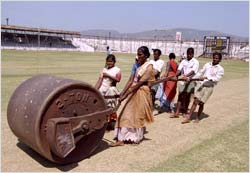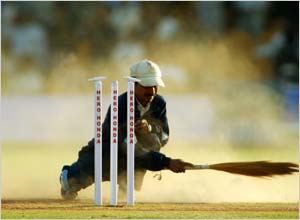Home > Cricket > Report
On the beaten track
Faisal Shariff |
May 12, 2003 20:07 IST
Board of Control for Cricket in India president Jagmohan Dalmiya announced a meeting of skippers and coaches of Ranji Trophy teams, designed to get feedback on the tournament's new format and other matters pertaining to domestic cricket.
On the agenda are questions such as revising the re-structured Duleep Trophy, gymnasiums for state associations, et al.
Interestingly, the single biggest issue, that of domestic pitches, has been left out of the agenda.
Indian Test stars have been asking for sporting wickets for some time now. Sachin Tendulkar, for one, said in an interview last year: "I had said quite a few things when I was captain in 1996-1997. I had made a statement that the Board and the groundsmen should take it seriously.
 "Domestic cricket needs to be changed completely, and we can do that by changing the tracks. We need to have sporting tracks, and it needs to support the fast bowlers and then the spinners, so that it becomes a very fair game."
"Domestic cricket needs to be changed completely, and we can do that by changing the tracks. We need to have sporting tracks, and it needs to support the fast bowlers and then the spinners, so that it becomes a very fair game."
The idea of relaying pitches in the country was in fact first mooted by Dalmiya in 1997; his election to the International Cricket Council's chair put that plan on hold. Subsequently, a pitches committee was formed and headed, successively, by Kapil Dev and Krishnamachari Srikkanth; no progress was made during this period, however.
"They (Dev and Srikkanth) told us to do as we please," said a member of the pitches committee, referring to that period.
A year ago Dalmiya had, in a welcome move, invited the NZSTI to study the condition of pitches in the country, and relay 10 pitches at leading venues.
A report by the pitches committee, and copies of correspondence between that body and the BCCI acquired by rediff.com suggests that the board has failed to initiate the process of implementing the suggestions of the New Zealand Sports Turf Institute.
The NZSTI is renowned worldwide for laying golf courses, football and cricket fields. Directors Keith McAuliffe and Bill Walmsley visited India twice, and presented the board with a comprehensive report.
Walmsley, an agronomist with 23 years experience in soil, grass selection and wicket science, visited grounds in Bangalore, Mumbai, Ahmedabad, Rajkot, Mohali, Kanpur, Nagpur, Kolkata, Cuttack and Chennai last September. His report updated the one submitted in May 1997, by Keith McAuliffe and Russell Smith. The reports made various recommendations for improving the condition of pitches across the country.
Thanks to bad scheduling, relaying work began late, with the result that the pitches in use for the Test series between India and West Indies last year were undercooked, and a bad advertisement for the effort.
Walmsley had cautioned that the relaid pitches would take a while to settle in, and that it would be counter-productive to have immediate expectations. He said it would take 12-18 months before such pitches provided the desired pace and bounce.
The Walmsley report further advises the board to call for a seminar for curators and/or head groundsmen. The intention, the report said, was to institute a uniform policy, or basic method of preparing and maintaining sporting wickets for both domestic and international cricket.
Walmsley also advocates longer tenures for curators, in order that there is continuity in the process of upgradation.
Chief curator and chairman of the grounds and wickets committee G Kasturi Rangan blames the various associations for not complying with the specifications.
The pitches committee has sent innumerable reminders to the board president, asking that prompt action be taken on the NZSTI report; thus far, the board is yet to respond.
 "Most of the mukadam (groundsmen) are lazy and just order for the heavy 2.5 ton roller, which makes the pitch docile," said a member of the pitch committee.
"Most of the mukadam (groundsmen) are lazy and just order for the heavy 2.5 ton roller, which makes the pitch docile," said a member of the pitch committee.
Ignorance and non-accountability are two factors, but equally so are the meager pay scales applying to ground staff.
"The main mukadam in Ahmedabad gets a piddly amount of Rs 2,000 per month -- and typically, this is for someone who has been working for 20-25 years. Other ground staff get Rs 50 per day when they work," says Nadeem Memon who, as curator of the Wankhede, is among the luckier ones, gets Rs 4500 per month.
Compare those wages with what the members of the pitches committee make. Committee chief Kasturi Rangan gets a monthly packet of Rs 25,000, other members of the committee make Rs 20,000 apiece.
All of them are 'honorary' members of the board.
Grounds that, despite all these handicaps, have adhered to the NZSTI plan have shown promising results, well inside the 18 months Walmsley said it would take for results to show.
At the Wankhede, for instance, the Ranji Trophy final last year yielded good batting, good pace and spin bowling, and an outright result - a rarity in domestic cricket, where results are usually on the basis of first innings scores.
For now, India is happily situated -- there is no international cricket planned till New Zealand come visiting in September. If all concerned get their acts together, this would be a great time to upgrade pitches, and ensure they are in shape ahead of that tour, and the season to follow.
But for this to happen, the board has first to acknowledge, and respond to, the NZSTI proposals, and the report of the pitches committee.
Highlights of the NZSTI report:
The performance of cricket pitches will improve where:
1. A fresh pitch is used.
2. Higher moisture is maintained in the soil.
3. A minimum of five days uninterrupted preparation is available beforehand.
4. Good soil density is achieved to 75mm depth.
5. A precise preparation programme is used.
Factors that can limit the performance of cricket pitches in India are:
1. Very heavy cricket used (Often 200-250 days per year), requiring multiple re-use of pitches.
2. Lack of time for proper preparation leading up to matches.
3. The perception that the rules of cricket do not allow watering of the cricket square during matches.
4. The likelihood that allowing the block to dry out and crack before being re-wet is destroying density achieved by pre-season rolling.
5. The need for properly trained, and experienced curators to use a precise cricket pitch preparation programme.
6. In some cases the soil used has limited potential to perform to expectations.
Specific action to improve cricket pitch performance is:
1. To prioritise cricket played on the main stadium so that international and important state matches are played on fresh pitches.
2. To limit play on the main stadium so that priority matches have an adequate preparation time beforehand (no less than 6-7 days).
3. To accept that better quality pitches will result where pitches are given adequate preparation time. This means playing a lesser number of lower grade and age group matches.
4. For the BCCI to explicitly state in the playing conditions for domestic cricket that hand watering of the cricket square (but not the playing strip) is allowed during matches, provided certain protocols are followed. This will allow a more constant moisture content to be maintained in the block and prevent loss of density by cracking.
5. A curator training course is implemented, together with a formalised programme of curator meetings for the purposed of sharing experiences and expertise.
6. The state cricket associations should be encouraged to appoint honorary curators for the main stadiums for a 3 to 5 year period, rather than the curator being up for election each year. The larger venues should be encouraged to eventually appoint a professional curator. Associations need to deal with questions of training, succession and continuity of curators.
7. The expertise of experienced groundsmen and malis should be recognised with improved status for " Head Groundsmen" so their services are retained for the benefit of cricket. In some cases theirs is the only experience retained where changes of curator are frequent.
8. In most grounds outfield-mowing capacity is not adequate.
9. A number of grounds have installed pop-up sprinkler irrigation in the outfield.
The complete NZSTI report : Inspection of Ten reconstructed cricket grounds.